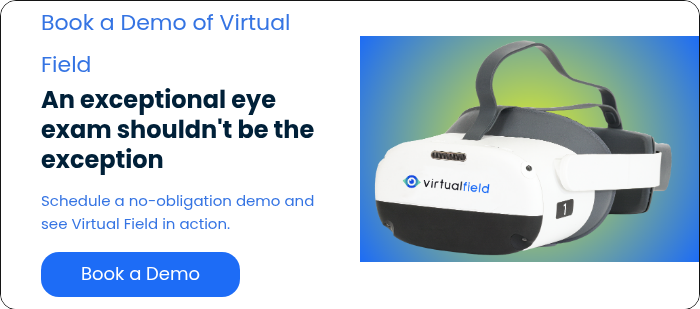Glaucoma malpractice claims represent one of the most costly and damaging legal risks in eye care, threatening both patient outcomes and provider reputations. When patients suffer irreversible vision loss due to a delayed or missed diagnosis, the resulting glaucoma misdiagnosis lawsuit can devastate practices both financially and professionally. Understanding these risks and implementing proactive diagnostic strategies, particularly visual field testing for glaucoma, is essential for protecting both patients and practitioners.
The Significant Risks of A Missed Glaucoma Diagnosis
Glaucoma is the second leading cause of irreversible blindness worldwide, affecting over three million Americans and 80 million people globally. It often progresses silently, without noticeable symptoms, until advanced stages. Its insidious nature makes early detection crucial to preserving vision. Unfortunately, failure to diagnose glaucoma in a timely manner is not only a clinical failure but also a significant glaucoma malpractice risk.
Practices that fail to diagnose or manage glaucoma effectively may face serious consequences, including glaucoma malpractice lawsuits, regulatory penalties, and reputational harm. Patients and legal representatives increasingly expect adherence to clinical standards, and glaucoma is an area where such expectations are high. When patients suffer permanent vision loss due to delayed or missed diagnoses, glaucoma-related practice litigation is a likely outcome. Eye care providers must understand that you can be sued for missing a glaucoma diagnosis, even in cases without overt symptoms.
Why Glaucoma Diagnoses Are Frequently Missed
Several clinical and procedural factors contribute to missed glaucoma diagnoses:
- Slow progression and lack of early symptoms: Many patients with early-stage glaucoma are asymptomatic. As a result, they may not seek care or may not report visual changes that could prompt further investigation.
- Over-reliance on intraocular pressure (IOP): Many practitioners rely too heavily on intraocular pressure measurements as the primary screening tool for glaucoma. While elevated IOP remains an important risk factor, approximately 30% of glaucoma cases occur with normal or low pressure. This normal-tension glaucoma can easily be overlooked when IOP readings fall within typical ranges, leading practitioners to dismiss glaucoma as a possibility.
- Incomplete patient history or infrequent follow-ups: Missing family history, medication use, or systemic diseases like diabetes can result in an incomplete glaucoma risk management assessment. Additionally, inconsistent follow-up schedules reduce opportunities for early detection.
- Failure to order appropriate diagnostic tests: Clinicians may overlook visual field testing or optic nerve imaging, especially in the absence of clear symptoms. Without functional testing, early glaucomatous damage often goes undetected.
Understanding the Legal Risk: Malpractice and Missed Glaucoma
Glaucoma malpractice risk typically centers on allegations of failure to diagnose, delayed diagnosis, or inadequate monitoring of known disease. These cases often result in substantial damage awards, as courts recognize the devastating impact of preventable vision loss on patients' quality of life and earning capacity.
Legal Definitions and Standards of Care
Legal definitions of "failure to diagnose" vary by state, but generally require plaintiffs to demonstrate that a reasonably competent practitioner would have identified the condition under similar circumstances. Courts evaluate whether the defendant followed accepted standards of care, including:
- Appropriate screening protocols
- Diagnostic testing procedures
- Follow-up monitoring requirements
The standard of care for glaucoma screening has undergone significant evolution. Today, best practices call for comprehensive evaluation of at-risk patients, including detailed optic nerve assessment, glaucoma visual field testing protocol, and consideration of multiple risk factors beyond IOP. Practitioners who fail to meet these evolving standards increase their risk of being sued for misdiagnosing glaucoma.
Real Case Example: $15 Million Award
A compelling glaucoma malpractice example occurred in New York, where a 20-year-old pregnant woman repeatedly sought care for blurred vision and eye pressure during prenatal visits. Despite visiting the hospital six times with consistent symptoms, doctors never diagnosed her with glaucoma. Two months later, she could not see her newborn son, and by the time surgery was performed one month after official diagnosis, she was left 90% blind. A jury awarded her $15 million in damages.
This case illustrates how failure to recognize obvious warning signs and implement appropriate diagnostic testing can result in catastrophic outcomes and substantial legal implications of delayed glaucoma diagnosis.
The Role of Visual Field Testing in Early Glaucoma Detection
Visual field testing for glaucoma, also known as perimetry, plays a central role in diagnosing and managing the disease. Unlike structural tests that assess optic nerve appearance, perimetry detects functional vision loss, often before visible changes occur.
Key benefits include:
- Early detection: Perimetry can uncover subtle vision loss that would not otherwise be apparent through IOP measurements or optic nerve assessment.
- Routine and comparative testing: For patients at high risk, regular glaucoma visual field testing enables clinicians to monitor changes over time, identifying progression before symptoms appear.
- Legal and clinical documentation: Visual field results establish baseline data and support treatment decisions. Detailed documentation of test outcomes, clinical impressions, and follow-up plans helps create a defensible medical record in the event of a glaucoma misdiagnosis lawsuit.
The American Academy of Ophthalmology and other professional bodies recommend visual field testing as part of a comprehensive glaucoma workup, particularly in patients with suspicious optic nerve findings or elevated IOP.
Regular Testing as a Legal Safeguard
Routine visual field testing for glaucoma serves as a powerful safeguard by demonstrating adherence to established clinical guidelines and standards of care. When practitioners can document systematic screening and monitoring, they strengthen their ability to protect their practice from glaucoma malpractice claims.
Baseline visual field testing helps detect early glaucomatous damage even when symptoms are absent, particularly in high-risk populations. This proactive approach aligns with current standards of care and demonstrates professional diligence in patient management. Accurate documentation of initial visual fields enables clinicians to monitor disease progression over time and adjust treatment plans accordingly. Without baseline data, determining whether vision loss represents new damage or a pre-existing condition becomes extremely difficult.
Establishing baselines is considered a fundamental part of glaucoma risk management. Clinically, failing to obtain baseline measurements may result in delayed diagnosis or inappropriate treatment decisions. Legally, the absence of baseline data can be interpreted as a deviation from accepted standards of care.
Consistent glaucoma visual field testing protocols create defensible records that support clinical decisions and document patient care quality. These records are invaluable in legal proceedings and a key strategy in avoiding malpractice in optometry.
Virtual Visual Field Testing: Making Compliance Easier
Virtual visual field testing is a practical solution for eye care practices aiming to enhance compliance while minimizing diagnostic oversights. Its portability and accessibility allow clinicians to administer tests in a broader range of settings, including community clinics, mobile units, and smaller exam rooms. This flexibility leads to more testing opportunities, especially for high-risk individuals such as elderly patients, those with a family history of glaucoma, or individuals with elevated intraocular pressure.
From an operational perspective, virtual visual field testing simplifies the process of documentation and data storage. Digital interfaces often integrate with electronic health records (EHR), reducing the risk of lost or incomplete documentation, a key component in defending against glaucoma malpractice risks. Virtual tools also tend to increase patient compliance due to their convenience and shorter testing duration. Improved patient follow-through supports the legal defensibility of care by ensuring consistent adherence to screening standards and providing crucial data in the event of a glaucoma misdiagnosis lawsuit.
Best Practices to Avoid Diagnostic Oversights
To reduce the risk of glaucoma malpractice claims, implement the following best practices:
- Establish testing frequency. Follow evidence-based glaucoma diagnosis guidelines to determine when and how often to test patients at high risk. This includes individuals over age 60, those with a family history of glaucoma, or those with elevated IOP.
- Create follow-up protocols. Use automated scheduling or EHR reminders to ensure timely follow-ups for patients flagged as high risk.
- Train staff. Educate clinical and administrative personnel on glaucoma risk factors, documentation standards, and referral protocols.
- Leverage technology. Integrate diagnostic imaging and virtual visual field testing platforms, such as Virtual Field, into the standard workflow. Ensure all results are logged and reviewed consistently.
Conclusion: Early Testing = Better Outcomes for Patients and Your Practice
Failure to diagnose glaucoma in a timely manner can result in permanent vision loss for patients and significant legal exposure for your practice. Proactively incorporating visual field testing for glaucoma, particularly using virtual platforms, is a practical and evidence-based approach to improve outcomes and limit liability.
By leveraging tools that support timely testing, documentation, and monitoring, practices can strengthen patient care and reduce exposure to glaucoma misdiagnosis lawsuits. Early visual field testing isn't just a clinical best practice – it's a cornerstone of effective glaucoma risk management and a key step in avoiding malpractice in optometry.
About Virtual Field
Virtual Field delivers an exceptional eye exam experience. Eye care professionals including ophthalmologists and optometrists examine patients faster, more efficiently, and more comfortably than ever before. Exams include Visual Field, 24-2, Kinetic Visual Field (Goldmann Perimetry), Ptosis, Esterman, Color Vision, Pupillometry, Extraocular Motility (EOM), and more.


